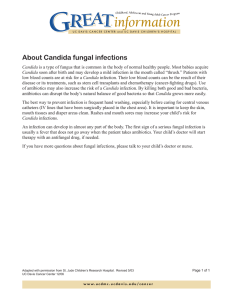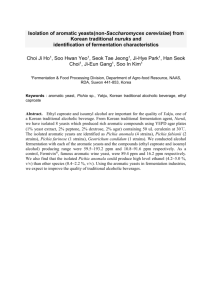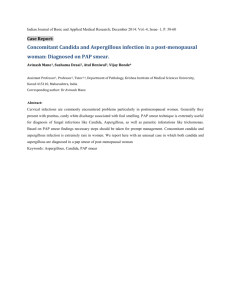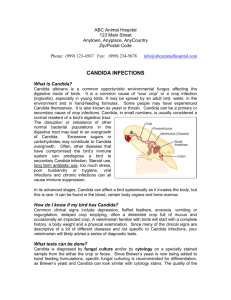c - Microbiology
advertisement
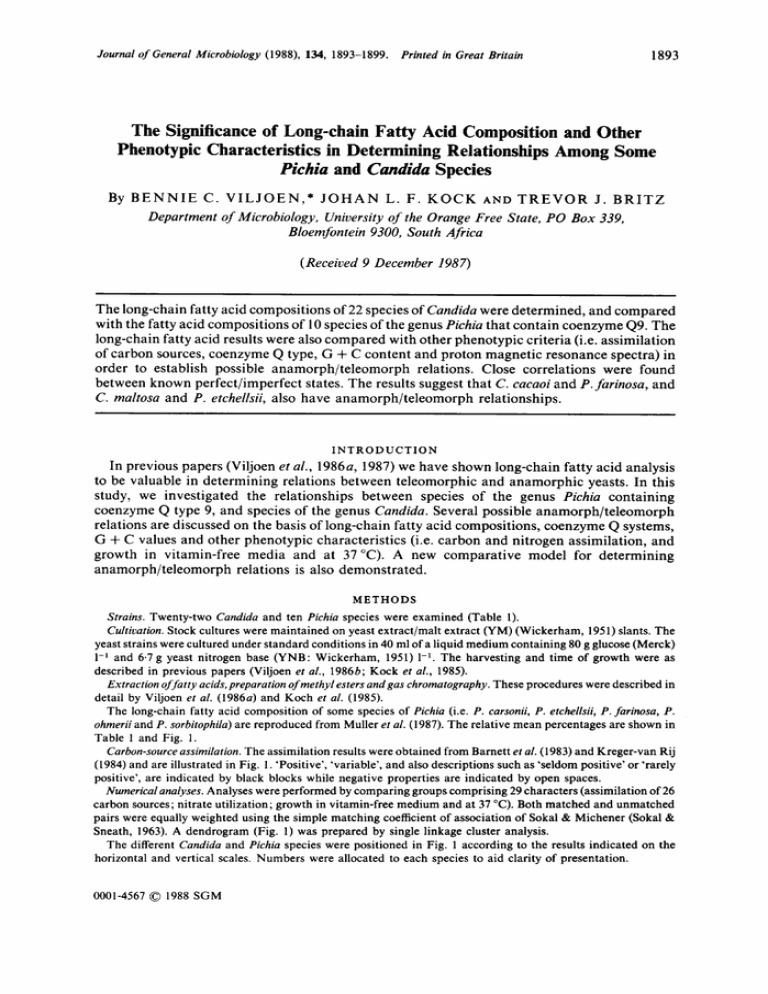
Journal of General Microbiology (1988), 134, 1893-1899. Printed in Great Britain 1893 The Significance of Long-chain Fatty Acid Composition and Other Phenotypic Characteristics in Determining Relationships Among Some Pichia and Candida Species By B E N N I E C . V I L J O E N , * J O H A N L . F. K O C K A N D T R E V O R J . B R I T Z Department of Microbiology, University of the Orange Free State, PO Box 339, Bloemfontein 9300, South Africa (Received 9 December 1987) The long-chain fatty acid compositions of 22 species of Candida were determined, and compared with the fatty acid compositions of 10 species of the genus Pichia that contain coenzyme Q9. The long-chain fatty acid results were also compared with other phenotypic criteria (i.e. assimilation of carbon sources, coenzyme Q type, G C content and proton magnetic resonance spectra) in order to establish possible anamorph/teleomorph relations. Close correlations were found between known perfect/imperfect states. The results suggest that C.cacaoi and P .farinosa, and C. maltosa and P. etchellsii, also have anamorph/teleomorph relationships. + INTRODUCTION In previous papers (Viljoen et al., 1986a, 1987) we have shown long-chain fatty acid analysis to be valuable in determining relations between teleomorphic and anamorphic yeasts. In this study, we investigated the relationships between species of the genus Pichia containing coenzyme Q type 9, and species of the genus Candida. Several possible anamorph/teleomorph relations are discussed on the basis of long-chain fatty acid compositions, coenzyme Q systems, G C values and other phenotypic characteristics (i.e. carbon and nitrogen assimilation, and growth in vitamin-free media and at 37°C). A new comparative model for determining anamorph/teleomorph relations is also demonstrated. + METHODS Strains. Twenty-two Candida and ten Pichia species were examined (Table 1). Cultivation. Stock cultures were maintained on yeast extract/malt extract (YM) (Wickerham, 1951) slants. The yeast strains were cultured under standard conditions in 40 ml of a liquid medium containing 80 g glucose (Merck) 1-1 and 6.7 g yeast nitrogen base (YNB: Wickerham, 1951) 1-I. The harvesting and time of growth were as described in previous papers (Viljoen et al., 19866; Kock et al., 1985). Extraction offatty acids, preparation of methyl esters and gas chromatography. These procedures were described in detail by Viljoen et al. (1986~)and Koch et al. (1985). The long-chain fatty acid composition of some species of Pichia (i.e. P . carsonii, P . etchellsii, P . farinosa, P . ohmerii and P. sorbitophila) are reproduced from Muller et al. (1987). The relative mean percentages are shown in Table 1 and Fig. 1. Carbon-sourceassimilation. The assimilation results were obtained from Barnett et al. (1983) and Kreger-van Rij (1984) and are illustrated in Fig. I . ‘Positive’, ‘variable’, and also descriptions such as ‘seldom positive’ or ‘rarely positive’, are indicated by black blocks while negative properties are indicated by open spaces. Numerical analyses. Analyses were performed by comparing groups comprising 29 characters (assimilation of 26 carbon sources; nitrate utilization; growth in vitamin-free medium and at 37 “C).Both matched and unmatched pairs were equally weighted using the simple matching coefficient of association of Sokal & Michener (Sokal & Sneath, 1963). A dendrogram (Fig. 1) was prepared by single linkage cluster analysis. The different Candida and Pichia species were positioned in Fig. 1 according to the results indicated on the horizontal and vertical scales. Numbers were allocated to each species to aid clarity of presentation. 0001-4567 0 1988 SGM Downloaded from www.microbiologyresearch.org by IP: 78.47.19.138 On: Sat, 01 Oct 2016 21:56:19 1894 B . C . V I L J O E N , J . L . F . K O C K A N D T. J . BRITZ Table 1. Mean percentage long-chain fatty acid composition of the species representing Candida and Pichia Values are the means of three repetitions. Fatty acids are designated as number of carbon atoms :number of double bonds. Group Strain no.* Species C14:O C14:l C16:O C16:l C18:O C18:l C18:2 C18:3 I C. oregonensis CBS 5036 0.2 0.7 15.2 14.8 1.0 23.7 38.1 IIA. C. catenulata C. santamariae C. zeylanoides C. glaebosa P . stipitis C. shehatae Mean Standard deviation CBS 564 CBS 4515 CSIR-Y979 CSIR-Y581 CSIR-Y633 CSIR-Y492 0.4 0.1 0.1 0.2 0.2 0.9 0.32 0.31 0.6 0.1 0.1 0-1 0.1 0.1 0.18 0.20 14.0 11.2 10.0 13.0 20.3 16.9 14.23 3.81 9.8 8.3 2.7 4.0 10.3 9.4 7.4 1 3.24 2.4 1.2 1-7 3.7 4.8 4.8 3.10 1.56 41.4 43.7 43.8 33.4 36.2 36.7 39.20 4.36 27.3 31.3 29-4 33.1 26.2 23.8 28.50 3-43 1.8 3.3 10.4 12.8 0-9 2.1 5.2 1 5.06 IIB. C. rugosa P . scolyti C. silvicultrix C. entomophila C. dendronema P . mexicana Mean Standard deviation CSIR-Y299 CBS 4802 CSIR-Y48 1 CSIR-Y479 CBS 6270 CBS 7066 0.3 0.2 0-2 0.2 0.1 0.1 0.18 0-07 0.2 0.1 0.1 0.1 0-2 0.1 0.13 0.05 14.5 17.7 15.8 12.5 27.8 25.9 19-03 6.31 3.8 4.8 3.6 3.8 8.3 9.5 5.63 2.59 0.4 3.2 2.3 3-2 4.4 2.0 2.58 1.36 55.0 40.3 41.9 49.3 35.3 37.5 43-21 7.50 20.3 27.4 20.5 26.0 15.3 18.9 21.4 4.50 3.6 6.4 10.5 3.1 5.1 4.1 5.46 2.73 IIC. C. quercitrusa P . ohmerii C. tenuis C. guilliermondii P . guilliermondii Mean Standard deviation CBS 4412 CBS 568 CSIR-Y566 CSIR-Y47 CBS 2030 0-3 0.2 0.3 0.1 0.1 0.20 0.10 0.1 0.1 0.1 0.1 0-1 0.10 0.00 19.9 12.3 13.9 18.5 19.1 16.75 3.38 3.7 4.7 11.5 8-3 9.6 7.56 3-29 2.0 53.2 4.4 63.7 3.2 54-8 5.8 54.7 4.6 50.1 4.00 55-30 1-44 5.06 14.6 12.0 11.9 10.6 14.3 12-68 1.71 4.6 2.4 3.8 1.5 1.8 2.82 1.33 I11 P . haplophila C. maltosa P . etchellsii Mean Standard deviation CBS 2028 CBS 561 1 CBS 2011T 0.2 0.2 0.2 0.20 0.00 0.3 0.2 17.1 16.6 14.0 15.90 1.66 7.8 8.7 7-8 8.10 0.5 1 1.5 4.6 2.9 3.00 1.55 26.6 28.9 31.1 28.86 2.25 46.8 40.7 43.7 43.73 3.05 - C. schatavii P . sorbitophila C. cacaoi P . farinosa C. blankii P . carsonii C. hydrocarbofumarica Mean Standard deviation CBS 6452 CBS 7064T CBS 202 NRRL Y-7553 CBS 1898 NRRL Y-4275 CBS 6734 18.7 13.3 9.3 9.4 16.2 16.3 16.8 14.28 3.72 2.6 3.6 3.0 4.0 2-4 2.7 3.0 3-04 0.57 10.4 0.6 0.9 1.0 3.7 2.4 8.5 3.92 3.95 48.4 69.3 53.7 56.3 49.2 51.7 49.8 54.05 7.26 18.0 12.7 25.9 22.8 26.9 26.5 19.7 21.78 5.28 - C. gropengiesseri C. magnoliae C. versatilis C. intermedia Mean Standard deviation CBS 156 CSIR-Y449 CBS 1731 CSIR-Y78 70.3 71.4 62.7 73.1 69.37 4-59 - IV V - 0.16 0.15 0.2 0.2 0.1 0.1 0.1 0.1 0.2 0.14 0.05 0.1 0.04 0.05 0.8 0.2 0.1 0.1 0.30 0.33 0.6 0.2 0.2 0.1 0.27 0.22 0.1 - 0.1 - - 5.1 8-8 6.9 2.9 5.92 2-51 11.0 15.9 22.7 15.9 16.37 4.80 8.2 2.3 5.9 4.9 5.32 2.44 - - 6-3 - - - - * CBS, Centraalbureau voor Schimmelcultures, Yeast Division, Delft, The Netherlands; CSIR-Y, cultures obtained from Professor J. P. van der Walt, Pretoria, South Africa; NRRL, Northern Regional Research Laboratories, Peoria, Illinois, USA. Downloaded from www.microbiologyresearch.org by IP: 78.47.19.138 On: Sat, 01 Oct 2016 21:56:19 Relationships between Candida and Pichia 1895 RESULTS A N D DISCUSSION Cellular long-chainfatty acid compositions Reproducible results were obtained when the 32 strains representing the genera Candida and Pichia were grown in triplicate under standard conditions. The mean fatty acid compositions are shown in Table 1. The species were mainly characterized by the presence of palmitic acid (C 16 :0), palmitoleic acid (C 16 : l), stearic acid (C 18 :0), oleic acid (C 18 :l), linoleic acid (C 18 :2) and linolenic acid (C18 : 3). They could be divided into five groups according to the presence of linoleic acid (C18 :2) and linolenic acid (C18 :3) and the mean percentage oleic acid (C18 :1) (Table 1). Group I, characterized by a pronounced high mean percentage linoleic acid (C18:2), the presence of linolenic acid (C 18 :3) and a low mean percentage oleic acid (C 18 :1) consisted of the single species Candida oregonensis. Group I1 comprised 12 Candida species and five Pichia species; it was subdivided into three subgroups based on the ratios between oleic acid (C18 : l), linoleic acid (C18 :2) and linolenic acid (C18 : 3). Subgroup A comprised those species which had high mean percentages of oleic acid (C18 : 1) and linoleic acid (C18 :2); subgroup B included species with a lower mean percentage of linoleic acid (C18 :2) and a higher mean percentage of oleic acid (C18 :1); and subgroup C comprised species which had much higher mean percentages of oleic acid (C18 : 1) and a lower mean percentage of linoleic acid (C 18 :2). Group 111, characterized by the absence of linolenic acid (C18:3) and a higher mean percentage of linoleic acid (C 18 : 2) than oleic acid (C 18 : l), included P . etchellsii, C. maftosaand P . haplophila. Group IV comprised species containing no linolenic acid (C18:3) and a higher mean percentage of oleic acid (C18 : 1) than linoleic acid (C18 :2). Group V included species which produced pronounced high mean percentages of oleic acid (C18 : 1) and no linoleic acid (C18 : 2) or linolenic acid (C18 : 3). Anamorph/teleomorph relations Several criteria should be met before an anamorph non-spore forming yeast is ascribed to a specific ascosporogenous teleomorph yeast. Anamorph/teleomorph relations are mainly based on morphological and physiological properties (Van Uden & Buckley, 1970; Meyer et al., 1984). Other criteria, however, such as the coenzyme Q type (Phaff, 1984; Yamada & Kondo, 1972), the degree of DNA relatedness (LethBak & Stenderup, 1969; Nakase & Komagata, 1971), cellular long-chain fatty acid compositions (Viljoen et al., 1987), proton magnetic resonance spectra (Manachini, 1979; Spencer & Gorin, 1969), serological studies (Montrocher, 1982; Tsuchiya et al., 1965) and electrophoretic comparison of enzymes (Yamazaki & Komagata, 1982), are all useful methods in correlating the relationships between imperfect and perfect yeasts. Most investigators agree that these phenotypic and genetic characteristics should be applied coordinately in order to correctly assign imperfect yeasts to perfect yeast forms. In this study the similarities between 32 species, representing the genera Pichia and Candida, were determined on the basis of cellular long-chain fatty acid compositions, carbon-source assimilation, and the ability to utilize nitrate and to grow in a vitamin-free medium and at 37 "C. These characteristics were used coordinately in a new model (Fig. 1). The results obtained were compared with other criteria, viz. G C values, proton magnetic resonance spectra and enzyme studies, in order to evaluate possible new teleomorph/anamorph relations. + Anamorphic yeasts having a known perfect stage. The known anamorph/teleomorph-related yeasts are all closely positioned in Fig. 1 (enclosed in boxes), which indicates a high similarity in cellular long-chain fatty acid composition and other phenotypic characteristics. (a) C. shehatae and P . stipitis. C. shehatae and P . stipitis, the species regarded as its perfect counterpart (Buckley & Van Uden, 1967), have similar long-chain fatty acid compositions (Viljoen et a f . ,1987), carbon-source assimilation patterns (>90% similarity) and G C values [42.5 mol% for P . stipitis (Miranda et al., 1982) and 41.2 mol% for C. shehatae (Nakase & Komagata, 1971)], and both have coenzyme Q type 9 (Yamada & Kondo, 1972). + Downloaded from www.microbiologyresearch.org by IP: 78.47.19.138 On: Sat, 01 Oct 2016 21:56:19 Downloaded from www.microbiologyresearch.org by IP: 78.47.19.138 On: Sat, 01 Oct 2016 21:56:19 70 oreg. - 19.C. I cat. 8.C. 7.C. :il. 26 0 C. rug. U !3.C. @. 12.P. mex. n glae. 9.P. p i p . 10.C. she. c 27 C. zey. 25 C. sun. 29.C. 18.P. 30 C. quer 3 .c. kuiI. I ohm 2, 3, 4, 18, 30 2 0 C. ten. I I .C. hyd. C 15. P. ,car. I 1.C. bla. 17.5. ma1 16. P. etc. U 230 C. car 14.C. ini. ' 7 , 1yi. C. g r 0 p . e . 32 31.C. mag. 21. C. ver. schar. 22. P. sor. far. c 28 P. hap. 16, 17, 18 Long-chain fatty acid composition I I 18, 9, 10, 25, 27, 2915, 6, 7, 12, 13, 36 I Relationships between Candida and Pichia 1897 (b) C. guilliermondii and P . guilliermondii. C. guilliermondii and its assumed perfect state, P . guilliermondii (Van Uden & Buckley, 1970) have similar long-chain fatty acid profiles (Table l), carbon-source assimilation patterns (>90% similarity) and G C values [44.1-44.4 mol % for C. guilliermondii (Nakase & Komagata, 1971) and 44.4 mol % for P . guilliermondii (Fuson et PI., 1980)], and both have coenzyme Q type 9 (Yamada & Kondo, 1972). + Yeasts having possible teleomorphlanamorph relations. (a) C. cacaoi and P . farinosa. These species produce similar long-chain fatty acid profiles (Fig. l), have ovoid cells and moderate to well-developed pseudomycelium, and show 82 % similarity in the assimilation of carbon sources. The two species are differentiated by the ability of P . farinosa to assimilate L-arabinose and Larabinitol (Fig. 1). They have similar G C values [42.5 mol % for P . farinosa and 41.7 mol % for C. cacaoi (Meyer & Phaff, 1972)] and proton magnetic resonance spectra (Gorin & Spencer, 1970). (b)C. maltosa and P . etchellsii. These species have similar long-chain fatty acid profiles (Table I), morphology [short ovoidal cells of equal size, and well-developed pseudomycelium) (Meyer et al., 1984; Kurtzman, 1984)] and physiological properties (>90% similarity), and both have coenzyme Q type 9 (Yamada & Kondo, 1972). According to the literature they are differentiated only by the ability of C. maltosa to assimilate L-arabinose and by the fermentation of galactose and trehalose (Meyer et al., 1984). A close relationship between these two yeasts is further indicated by their similar G C values [363 mol % for C. maltosa (Nakase & Komagata, 1971) and 38.5 mol % for P . etchellsii (Nakase & Komagata, 1970)l. + + Other Candida and Pichia species with similar long-chainfatty acidprojles. ( a ) C. blankii and P . carsonii.These two yeast species have almost identical long-chain fatty acid compositions (Table I), show 85% similarity in the assimilation of carbon sources (Fig. I), and produce similar cell shapes and abundant pseudohyphae. However, their G C values are very different [551 mol % for C. blankii (Meyer et al., 1984) and 39.6 mol % for P . carsonii (Kurtzman & Smiley, 1979)l. (b) C. dendronema and P . mexicana. These species have similar long-chain fatty acid compositions (Table l), and show 85% similarity in the assimilation of carbon sources (Fig. 1). Their G C values are 42.2 mol % for P . mexicana (Miranda et al., 1982) and 40.4 mol % for C. dendronema (Stenderup et al., 1972). (c) C. silvicultrix, C. entomophila and P . scolyti. These yeasts all have similar long-chain fatty acid profiles. C. silvicultrix and C. entomophila show 90%similarity in the assimilation of carbon sources and 85% similarity with P . scolyti. C. silvicultrix and P . scolyti both produce welldeveloped pseudomycelium with blastospores and ovoidal cells, of equal size. C. entomophila, on the other hand, produces true mycelium and cells of various shapes. There are major differences in G C values, however, between P . scolyti[40.1 mol % (Fuson etal., 1980)]and C . entomophila [54.0 mol % (Stenderup et al., 1972)]while C. silvicultrix has a lower value [366 mol % (Meyer et al., 1984)l. + + + Fig. 1 (on facing page). Relationships between species of Candida and Pichia, arranged according to carbon source utilization (vertical scale, left) and long-chain fatty acid composition (horizontal scale, top). Species known or believed to have anamorph/teleomorph relationships are enclosed in boxes. 1. C . hyd., Candida hydrocarbofumarica ;2. C . ten., Candida tenuis; 3. P . guil., Pichia guilliermondii;4. C . guil., Candida guilliermondii; 5 . C . ent., Candida entomophila; 6. P . scol., Pichia scolyti; 7. C . sil., Candida silvicultrix; 8. C . glae., Candida glaebosa; 9. P . stip., Pichia stipitis; 10. C . she., Candida shehatae; 11. C . bla., Candida blankii; 12. P. mex., Pichia mexicana; 13. C . den., Candida dendronema; 14. C . int., Candida intermedia; 15. P. car., Pichia carsonii; 16. P. etc., Pichia etchellsii; 17. C . mal., Candida maltosa; 18. P . ohm., Pichia ohmerii; 19. C . oreg., Candida oregonensis; 20. P . far., Pichia farinosa; 21. C . ver., Candida versatilis; 22. P . sor., Pichia sorbitophila; 23. C . cac., Candida cacaoi; 24. C . schat., Candida schatavii; 25. C . san., Candida santamariae; 26. C . rug., Candida rugosa; 27. C . zey., Candida zeylanoides; 28. P. hap., Pichia haplophila;29. C . cat., Candida catenulata; 30. C . quer., Candida quericitrusa; 31. C . mag., Candida magnoliae; 32. C . grop., Candida gropengiesseri. Key to lipid histograms: -, C16 :O (palmitic acid); m,C16:l (palmitoleic acid); .\\\, C18:O (stearic acid); 1111111, C18:l (oleic acid); 1 1 1 , C18:2 (linoleic acid); [/laC18 , : 3 (linolenic acid). For the carbon-source utilization data, black blocks denote positive, and white spaces denote negative. Downloaded from www.microbiologyresearch.org by IP: 78.47.19.138 On: Sat, 01 Oct 2016 21:56:19 1898 B . C . VILJOEN, J . L . F . KOCK A N D T . J . B R I T Z ( d ) C . schatavii and P . sorbitophila. Both species are characterized by the absence of linolenic acid (C18 : 3), and have similar fatty acid profiles and carbon-source utilization patterns (82% similarity). (e) C. tenuis and P . guilliermondii. These species have closely similar long-chain fatty acid compositions (Table l), coenzyme Q type 9 (Yamada & Kondo, 1972), 85% similarity in the assimilation of carbon sources (Fig. 1) and G C values of 44.0 mol % for C. tenuis (Stenderup & LethBak, 1968) and 44.4 mol % for P . guilliermondii. Furthermore, both species have ovoid to elongate cells of equal sizes and produce pseudomycelium and blastospores. + Teleomorph relations Based on the results in Fig. 1 we detected two distinct groups in the genus Pichia. The first group comprises all the species with hat-shaped ascospores (Kurtzman, 1984), i.e. P . stipitis, P . scolyti, P . mexicana, P . guilliermondii and P . ohmeri, characterized by the presence of linolenic acid (C18 : 3). The second group comprises those species which form spheroidal ascospores (except P . haplophila) and are characterized by the absence of linolenic acid (C18:3), i.e. P . sorbitophila, P . farinosa, P . etchellsii, P . carsonii and P . haplophila (Muller et al., 1987). Anamorph relations The highly heterogeneous nature of the genus Candida is reflected in Fig. 1. Species without linoleic (C18 :2) and linolenic (C18 :3) acids (C. gropengiesseri, C. magnoliae, C . versatilis and C . intermedia) showed no resemblance to Pichia species on the basis of long-chain fatty acid compositions. CONCLUSIONS According to the results the following conclusions are drawn. 1. The coordinate use of long-chain fatty acid composition and other phenotypic characters, as illustrated in Fig. 1, provides a useful model to determine similarities between yeasts (i.e. anamorph/teleomorph, anamorph and teleomorph relations). Imperfect yeasts of the genus Candida and their known perfect forms were similar in their long-chain fatty acid compositions and in other phenotypic characteristics. These yeasts were in all cases closely positioned in the coordinate scheme (Fig. 1). 2. The following anamorph/teleomorph associations are proposed : C. cacaoi and P . farinosa, C. maltosa and P . etchellsii. 3. A correlation seems to exist between the coenzyme Q type 9 Pichia species investigated which produce hat-shaped ascospores and the presence of linolenic acid (C18:3), and the coenzyme Q type 9 Pichia species which produce spheroidal ascospores (except for P . haplophila) and the absence of linolenic acid (C18:3). More strains and species should however be investigated before any generalization is made. 4. The heterogeneous nature of the genus Candida is clearly illustrated in the coordinate scheme (Fig. 1). The authors wish to thank Professor J. P. van der Walt of the CSIR, Pretoria, for supplying the yeasts, Mr P. J. Botes for assistance with gas chromatography, and Carol Viljoen for excellent secretarial assistance. REFERENCES BARNETT, J. A., PAYNE,R. W. &YARROW, D . (1983). Yeasts :Characteristics and Identgcation. Cambridge & New York: Cambridge University Press. H. R. & VAN UDEN,N. (1967). Candida BUCKLEY, shehatae sp. n., a yeast associated with wooddestroying insects. Mycopathologia et mycologia applicata 32, 297-30 1. FUSON,G. B., PRICE,C. W. & PHAFF,H. J. (1980). Deoxyribonucleic acid base sequence relatedness among strains of Pichia ohmeri that produce dimor- phic ascospores. International Journal of Systematic Bacteriology 30,2 1 7-2 19. GORIN,P. A. J. & SPENCER, J . F. T. (1970). Proton magnetic resonance spectroscopy - an aid in identification and chemotaxonomy of yeasts. Aduances in Applied Microbiology 13, 25-89. KOCK,J. L. F., LATEGAN,P. M., BOTES,P. J. & VILJOEN, B. C. (1985). Developing a rapid statistical identification process for different yeast species. Journal of Microbiological Methods 4, 147-1 54. Downloaded from www.microbiologyresearch.org by IP: 78.47.19.138 On: Sat, 01 Oct 2016 21:56:19 Relationships between Candida and Pichia KREGER-VAN RIJ, N. J. W. (editor) (1984). The Yeasts, a Taxonomic Study, 3rd edn. Amsterdam : Elsevier. KURTZMAN, C. P. (1984). Genus Pichia Hansen. In The Yeasts, a Taxonomic Study, 3rd edn, pp. 295-378. Edited by N. J . W. Kreger-van Rij. Amsterdam: Elsevier. KURTZMAN, C. P. & SMILEY, M. J. (1979). Taxonomy of Pichia carsonii and its synonyms P . vini and P . vini var. melibiosi: comparison by DNA reassociation. Mycologia 71, 658-662. LETHBAK,A. & STENDERUP, A. (1969). Deoxyribonucleic acid homology in yeasts. Genetic relatedness within the genus Candida. Journal of General Microbiology 59, 2 1-30. P. L. (1979). DNA sequence similarity, MANACHINI, cell wall mannans, and physiological characteristics in some strains of Candida utilis, Hansenula jadinii and Hansenula petersonii. Antonie van Leeuwenhoek 45, 451-463. MEYER,S. A. & PHAFF,H. J. (1972). DNA base composition and DNA-DNA homology studies as tools in yeast systematics. In Yeasts, Models in Science and Technics, pp. 375-386. Edited by A. Kockova-Kratochvilova & E. Minarik. Bratislava : Slovak Academy of Science. D. G . & YARROW,D. (1984). MEYER,S. A., AHEARN, Genus Candida Berkhout. In The Yeasts, a Taxonomic Study, 3rd edn, pp. 585-844. Edited by N. J. W. Kreger-van Rij. Amsterdam : Elsevier. MIRANDA,M., HOLZSCHU,D. L., PHAFF,H. J. & STARMER, W. T. (1982). Pichia mexicana, a new heterothallic yeast from cereoid cacti in the North American Sonoran Desert. International Journal of Systematic Bacteriology 32, 101-107. MONTROCHER, R. (1982). Serological studies among sporogenous and asporogenous yeasts : antigenic structures of some Candida and related taxa. Cellular and Molecular Biology 28, 197-2 11. MULLER,H. B., KOCK, J. L. F., BOTES, P. J. & LATEGAN, P. M. (1987). The cellular long-chain fatty acid composition of species representing the genus Pichia Hansen emend. Kurtzman. Systematic and Applied Microbiology 9, 280-283. K. (1970). Significance of NAKASE,T. & KOMAGATA, DNA base composition in the classification of yeast genus Pichia. Journal of General and Applied Microbiology 16, 511-521. NAKASE,T. & KOMAGATA, K. (1971). Significance of DNA base composition in the classification of the yeast genus Candida. Journal of General and Applied Microbiology 17, 259-279. PHAFF,H. J. (1984). DNA, enzymes and cell wall. In 1899 The Yeasts, a Taxonomic Study, 3rd edn, pp. 17-21. Edited by N. J. W. Kreger-van Rij. Amsterdam: Elsevier. SOKAL,R. R. & SNEATH, P. H. A. (1963). Principles of Numerical Taxonomy. London : W. H. Freeman. SPENCER, J. F. T. & GORIN,P. A. J. (1969). Systematics of the genus Candida Berkhout: proton magnetic resonance spectra of the mannans and mannosecontaining polysaccharides as an aid in classification. Antonie van Leeuwenhoek 35, 33-44. STENDERUP, A. & LETHBAK,A. (1968). Deoxyribonucleic acid base composition of some species within the genus Candida. Journal of General Microbiology 52, 231-236. STENDERUP, A., MEYER,S. A., LETHBAK,A. & CHRISTIANSEN, C. (1972). Taxonomy of Candida and Torulopsis. In Fermentation Technology Today. Proceedings of the IV International Fermentation Symposium, pp. 793-795. Edited by G. Terui. Osaka, Japan : Society of Fermentation and Technology. TSUCHIYA, T., FUKAZAWA, Y. & KAWAKITA, S. (1965). Significance of serological studies on yeasts. Mycopathologia et mycologia applicata 26, 1-1 5. VANUDEN,N. & BUCKLEY, H. (1970). Genus Candida Berkhout. In The Yeasts, a Taxonomic Study, 2nd edn, pp. 893-1087. Edited by J. Lodder. Amsterdam : North-Holland. VILJOEN,B. C., KOCK, J. L. F. & LATEGAN, P. M. (1986a). Long-chain fatty acid composition of selected genera of yeast belonging to the Endomycetales. Antonie van Leeuwenhoek 52, 45-5 1. VILJOEN,B. C., KOCK,J. L. F. & LATEGAN,P. M. (1986b). The influence of culture age on the cellular fatty acid composition of four selected yeasts. Journal of General Microbiology 132, 1895-1898. VILJOEN,B. C., KOCK, J. L. F., MULLER,H. B. & LATEGAN,P. M. (1987). Long-chain fatty acid compositions of some asporogenous yeasts and their respective ascosporogenous states. Journal of General Microbiology 133, 1019-1022. WICKERHAM, L. J. (1951). Taxonomy of Yeasts. Technical Bulletin no. 1029, United States Department of Agriculture. YAMADA, Y. & KONDO,K. (1972). Taxonomic significance of coenzyme Q system in yeasts and yeast-like fungi. In Yeasts, Models in Science and Technics, pp. 363-373. Edited by A. Kockovb-Kratochvilova & E. Minarik. Bratislava : Slovak Academy of Science. YAMAZAKI, M. & KOMAGATA, K. (1982). Asporogenous yeasts and their supposed ascosporogenous states : an electrophoretic comparison of enzymes. Journal of General and Applied Microbiology 28, 119-1 38. Downloaded from www.microbiologyresearch.org by IP: 78.47.19.138 On: Sat, 01 Oct 2016 21:56:19
